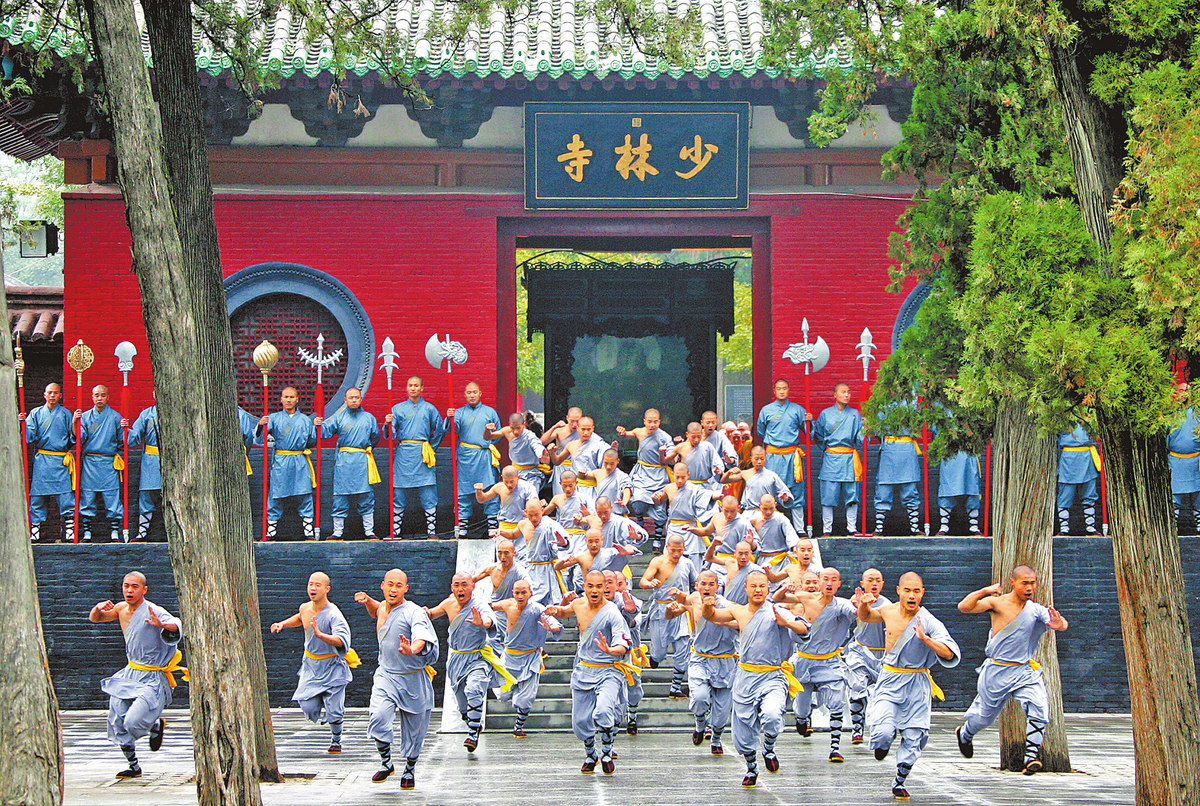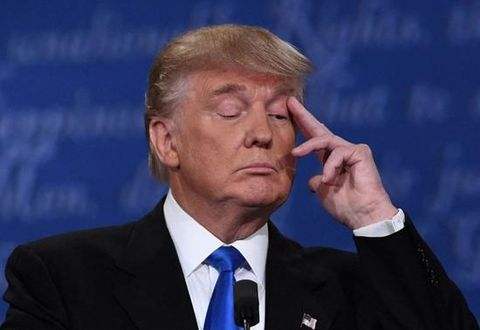
Sunset on the Yellow River. (Photo by Ma Jian)

Wushu performance in front of Shaolin Temple. (Photo by Ma Jian)

Damei Songshan Mountain. (Li Wei photo)
Sub-forum on "Diversity, Exchange and Mutual Learning of World River Civilization"
Promote the comparative study of civilizations in major river basins around the world.
At the sub-forum of "Diversity, Exchange and Mutual Learning of World River Civilization", scholars at home and abroad conducted in-depth exchanges around the theme of "Research on Ancient Civilization from a Global Perspective".
The achievements of the "Chinese Civilization Sourcing Project" confirmed that around 5,300 years ago, the vast areas including the Yangtze River, the Yellow River and the Xiliao River Basin entered the stage of civilization one after another, and all regions interacted closely, forming a "pluralistic and integrated" "China Interaction Circle", which laid the foundation for the origin of Chinese civilization.
Professor Han Jianye from Renmin University of China introduced the latest archaeological discovery of Nanzuo site in Qingyang, Gansu Province in the upper reaches of the Yellow River. Nanzuo site is one of the largest settlement sites in the late Yangshao culture about 5000 years ago. The grand scale of Nanzuo site and its strong organization and mobilization ability are the most powerful proof of the emergence of regional political power. Han Jianye said: "At that time, the Loess Plateau had clearly entered a civilized society and an early country appeared."
Hongshan culture is one of the pioneers and representatives of the origin of Chinese civilization. Jia Xiaobing, the leader of the archaeological team of Niuheliang Site and a researcher at the Institute of Archaeology of Chinese Academy of Social Sciences, introduced that a series of discoveries at Niuheliang Site in Liaohe River Basin revealed that Hongshan culture continued the long-standing tradition in the northern region during its occurrence and development, and at the same time accepted and integrated other regional traditions, forming an open and inclusive social system that valued etiquette and despised secularism, laying the foundation for the "original civilization" in the north.
Shijiahe site in Tianmen, Hubei Province is a prehistoric settlement group with the largest known distribution area, the most complete preservation, the longest duration and the highest level in the middle reaches of the Yangtze River. Professor Meng Huaping, deputy dean of the School of History and Culture of Hubei University, said: "From the late Qujialing culture to the Shijiahe culture, the middle reaches of the Yangtze River became an important representative of the diversified pattern of early Chinese civilization, and Shijiahe site was the most prominent carrier, which can be regarded as the center of early civilization in the middle reaches of the Yangtze River and has an important position of cultural guidance and cultural radiation."
Professor Tang Jigen of south university of science and technology of china Cultural Heritage Research Center believes that Shang Dynasty, as one of the representatives of the Yellow River civilization, showed outstanding innovation in writing, architecture, bronze casting, astronomical calendar and mathematics. Ran Honglin, director of Sanxingdui Archaeological Research Institute of Sichuan Institute of Cultural Relics and Archaeology, introduced the archaeological excavation, cultural relics protection and multidisciplinary research results of Sanxingdui site. He said: "Sanxingdui site shows the close communication between the ancient Shu civilization and the Xia and Shang dynasties in the Central Plains more than 3,000 years ago, which provides more powerful archaeological evidence for the pluralistic and integrated pattern of Chinese civilization." Fang Qin, president of Hubei Provincial Institute of Cultural Relics and Archaeology, introduced the excavation and research of Zeng Guo’s series of tombs in Zhou Dynasty. The series of archaeological discoveries of Zeng Guo unveiled the mystery of Zeng Guo, a Zhou Dynasty vassal state that did not exist in the literature, and built a history of Zeng Guo for more than 700 years, which also provided an important time scale for the study of Zhou Dynasty vassal States.
Sino-foreign joint archaeological achievements are rich. In 2015, the Institute of Archaeology of Chinese Academy of Social Sciences cooperated with the Honduran Institute of Anthropology and History to start the excavation of Copan site, an important city-state of Mayan civilization, which was the first archaeological project in Central China hosted by American archaeologists. In 2018, the first Sino-Egyptian joint archaeological team conducted archaeology in the Montu Temple area in northern Karnak, Egypt. At present, archaeological excavations have achieved initial results. Professor Yang Jianhua from the School of Archaeology of Jilin University made a comparative study on the origin of civilizations in the Yellow River basin and the two rivers.
"Dialogue between Chinese Civilization and World Civilization" Sub-forum-
Carry out the dialogue between Chinese civilization and world civilization
As one of the sub-forums of the 2023 World River Civilization Forum, the sub-forum "Dialogue between Chinese Civilization and World Civilization" (Songshan Forum 2023 Annual Meeting) opened in Dengfeng on September 16th. The theme of this year’s annual conference is "Strive for Self-improvement, Respect Virtue and Carry Forward the World Civilization", which is hosted by China International Cultural Exchange Center and Peking University Institute of Advanced Humanities. More than 30 scholars at home and abroad have conducted exchanges and dialogues on the theme.
Zhang Guangzhi, director of the Organizing Committee of Songshan Forum, said in his opening speech: "Self-improvement and morality are the essence of ideological wisdom left by Chinese ancestors."
Hertha nagel-Doskar, an academician of the International School of Philosophy and a professor of philosophy at the Vienna University, Wang Zhongjiang, Executive Dean of the Peking University Institute of Advanced Humanities, Jing Haifeng, a professor of Chinese Studies at Shenzhen University, Ren Jiantao, a professor of political science at Tsinghua University, Chen Xia, a researcher at the Institute of Philosophy of the Chinese Academy of Social Sciences, Liu Cheng, a professor of history at Nanjing University, and Yun Chen, a professor of philosophy at East China Normal University, delivered keynote speeches at the forum. Experts believe that spiritual issues are very important to contemporary philosophy; The rapid progress of contemporary civilization has opened up an unprecedented development space for China traditional culture; In today’s era, the human world must have a pluralistic, resilient and integrated vision of peace; The future destiny of the earth needs more moderate and effective global governance; It is urgent for the world to form an equal international order and solve the common problems of economy, ecology and so on.
On the afternoon of September 16th, the key link of the forum-"The Great Change and the Spiritual Turn of World Philosophy" was held under "General Bo" in Songyang Academy. Mary Evelyn Tucker, a lecturer at Yale University’s School of Environment, Yao Xinzhong, a professor at China Renmin University’s School of Philosophy, Deng Bingyuan, a professor at Fudan University’s Department of History, Ludwig nagel, a tenured professor at Vienna University, and Wang Zhihe, executive director of the US-China Institute of Postmodern Development, attended the dialogue. Dialogue scholars believe that with the development of history, how can we find a path to peace and cultural understanding through civilized dialogue? How to achieve sustainable development? This is worthy of attention.
The second day of the forum was held in Zhengzhou. Fang Zhaohui, a professor at Tsinghua University Humanities College, Chen Lisheng, a professor at Sun Yat-sen University’s Philosophy Department, John Grimm, a professor at Yale University’s School of Environment, Han Xing, a professor at China Renmin University’s National College, Hu Zhihong, a professor at Wuhan University’s China Traditional Culture Research Center, and Zhang Zailin, a professor at Xi ‘an Jiaotong University’s Humanities College. Su Hao, an associate professor at Sun Yat-sen University’s Philosophy Department, Chen Maoze, an assistant researcher at Peking University Institute of Advanced Humanities, More than 20 experts and scholars, such as Li Hansong, a research scholar in the government department of Harvard University, and Ke Leshan, a research scholar in Tubingen University, discussed two topics: "Pluralistic Modernity and the New Form of Human Civilization" and "Kundao Care from the Perspective of Spiritual Humanism". In the closing session, Qiao Qingju, a professor at the Party School of the Central Committee of the Communist Party of China (National School of Administration), gave a keynote speech entitled "The Civilization Significance of the View of the World".
Sub-forum on "Chinese Civilization and the Inheritance and Promotion of Yellow River Culture"
The resilience of the Yellow River culture and the continuity of Chinese civilization
The sub-forum "Chinese Civilization and the Inheritance and Promotion of Yellow River Culture" was held in Zhengzhou, Henan Province on September 17th, with the theme of "Resilience of Yellow River Culture and Continuity of Chinese Civilization". The sub-forum was hosted by the Yellow River Civilization and Sustainable Development Research Center of Henan University, and more than 40 scholars from nearly 20 units including China Academy of Social Sciences and Capital Normal University attended the forum. Wang Zhenzhong, a member of the Chinese Academy of Social Sciences, gave a keynote speech entitled "Colorful and eclectic Chinese culture and the inclusiveness of the Chinese nation". Fang Hui, Dean of the School of History and Culture of Shandong University, and Wei Jiyin, Executive Dean of the China Historical Research Institute-Huanghe Culture Research Institute of Henan University, presided over the keynote speech successively.
Chen Honghai, a professor at Northwest University, believes that the agricultural economy in the upper reaches of the Yellow River is the result of the westward expansion of Yangshao cultural agricultural population in the eastern neighboring areas. Since then, handicraft industry and commodity trade have gradually grown, and metallurgical technology has also been introduced and developed. Cultural exchange has promoted the process of civilization, and the social complexity of Qijia culture period shows that it has entered the early stage of civilization.
Huang Fucheng, a researcher at Zhengzhou Institute of Cultural Relics and Archaeology, said that 216 funerary objects, such as bronzes, goldsmiths and jades, were unearthed from M2, the main tomb of Shuyuan Street Cemetery in the southeast corner of Zhengzhou Mall, which is the noblest tomb with the largest number of funerary objects, the richest variety and the highest grade. Shuyuan Street Cemetery explains the key cultural connotation of Zhengzhou, the capital of Shang Dynasty, which plays an important role in the evolution of Xia-Shang civilization and is of great significance to explore the formation and development of the early national ritual and music system.
Hou Yongjian, a professor at Shaanxi Normal University, pointed out that the farming society in the Yellow River Basin has cultivated people’s peace-loving thoughts, a sense of preparedness for disasters, a moral culture characterized by "self-restraint", and a spirit of hard work, perseverance, self-improvement and courage to fight.
Liu Haiwang, president of Henan Institute of Cultural Relics and Archaeology, said that the Yellow River and the canals connected with it have increasingly influenced the development of Chinese civilization. At the latest in the Warring States period, the gap water system that artificially communicated the Yellow River and Huaihe River was formed, which strengthened the economic and cultural ties between the Central Plains and surrounding areas and created conditions for the reunification of Qin and Han Dynasties in the future. Since the opening of the Sui Dynasty, the Grand Canal connecting the north and the south has played an important role in the history of China.
Qi Shuyu, a professor at the Party School of the Central Committee of the Communist Party of China (National School of Administration), put forward that the cultural tourism belt in the Yellow River Basin should form a spatial structure with three zones cooperating, five zones in series and multi-point radiation. It is necessary to optimize the allocation of cultural tourism resources, handle the relationship between fairness and efficiency, part and whole, present and long-term, establish a collaborative mechanism of the Yellow River cultural tourism belt, and promote the coordinated development of the cultural tourism belt in the Yellow River basin.
Sub-forum on "Ecological Protection and High-quality Development in the Yellow River Basin"
Promoting High-quality Development and Building People’s Happiness River
On September 17th, the sub-forum on "Ecological Protection and High-quality Development in the Yellow River Basin" was held in Zhengzhou. This is one of the sub-forums of the 2023 World River Civilization Forum, which is hosted by Henan Academy of Social Sciences.
Experts and scholars from all over the country have formed a series of constructive views around the in-depth implementation of the strategy of ecological protection and high-quality development in the Yellow River Basin.
Promote the in-depth implementation of the strategy of ecological protection and high-quality development in the Yellow River Basin according to law. Experts attending the meeting said that the promulgation and implementation of the Yellow River Protection Law provided a solid legal guarantee for the mother river to maintain its vitality forever. It is necessary to include the Yellow River Protection Law in the important content of legal popularization, widely publicize the legislative intention, practical requirements and scope of application of the Yellow River Protection Law, and promote the whole society to form a good atmosphere of consciously respecting, learning, abiding by and using the law.
Systematically promote the great protection and governance of river basins. Experts attending the meeting believe that it is necessary to adhere to the system concept, base on the integrity of the whole basin and ecosystem, jointly do a good job in great protection, promote great governance in coordination, and build a baseline for ecological protection; It is necessary to take water resources as the greatest rigid constraint, coordinate the integrated protection and systematic management of mountains, rivers, forests, fields, lakes, grass and sand, and coordinate the protection and management of water environment, water ecology and water resources; It is necessary to adhere to local conditions and promote water conservation in the upper reaches, soil and water conservation and pollution control in the middle reaches, and wetland ecosystem protection in the lower reaches.
Solidly promote comprehensive green and low-carbon transformation. Experts attending the meeting put forward suggestions around the comprehensive green and low-carbon economic and social transformation of the Yellow River Basin: accelerating industrial ecologicalization and optimizing industrial structure and energy structure; Strengthen the guidance of green technology innovation direction.
Build and use the Yellow River National Cultural Park. Experts attending the meeting suggested that it is necessary to integrate resources, innovate methods and improve mechanisms to promote the scientific protection, rational utilization and generation-to-generation inheritance of important cultural heritage along the Yellow River.
Dig deep into the value of the Yellow River culture. Experts attending the meeting believe that it is necessary to systematically integrate the cultural resources of the Yellow River, explore new spirits, ideas and values in the protection and inheritance of the Yellow River culture, comprehensively enhance the historical, social and economic values of the Yellow River culture, form a cultural system of the Yellow River with new era characteristics, and gather spiritual strength for the great rejuvenation of the Chinese nation.
Deepen the development space of cultural tourism integration. Experts attending the meeting proposed to build a number of special cultural tourism routes of the Yellow River with local cultural elements, build a number of venues such as the Yellow River Museum and the Yellow River Cultural Experience Hall, and select a number of non-legacy projects such as traditional skills.
Actively carry out regional exploration. Experts attending the meeting summarized the practice and exploration of provinces along the Yellow River. Qinghai and Sichuan strengthened ecological restoration and comprehensive management, Gansu, Inner Mongolia and Shaanxi promoted comprehensive management of soil erosion, and Ningxia, Shanxi and Shandong accelerated the conversion of old and new kinetic energy.
Continuously strengthen river basin cooperation. Experts attending the meeting believe that with the in-depth implementation of the strategy of ecological protection and high-quality development in the Yellow River Basin, opportunities for inter-provincial regional cooperation are increasing, and the overall coordination mechanism should be improved as soon as possible to accelerate the realization of policy planning coordination, disaster prevention and mitigation linkage, law enforcement and supervision cooperation, and information sharing.
Continue to deepen the practice in Henan. Experts attending the meeting said that Henan should pay attention to giving full play to its advantages and highlighting its characteristics, especially as a major agricultural province, and should combine the implementation of rural revitalization strategy with the ecological protection and high-quality development strategy of the Yellow River Basin, protect the ecology, develop the industry and inherit the civilization, and strive to promote the comprehensive revitalization of the villages along the Yellow River; It is necessary to speed up the pace of reform, opening up and innovation, continuously stimulate internal vitality and promote high-quality economic and social development.

































